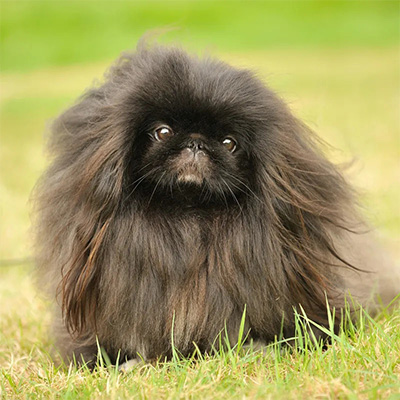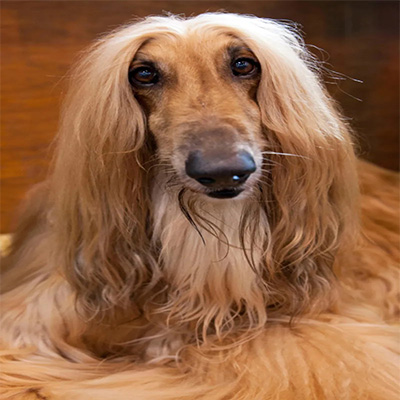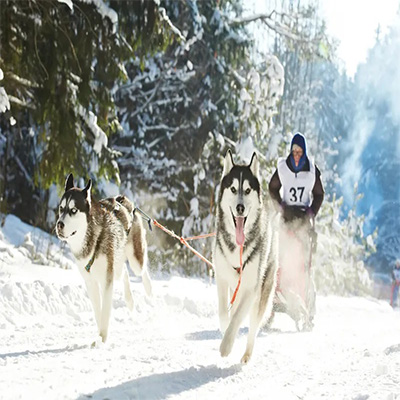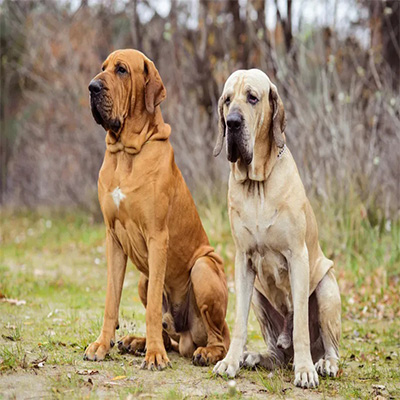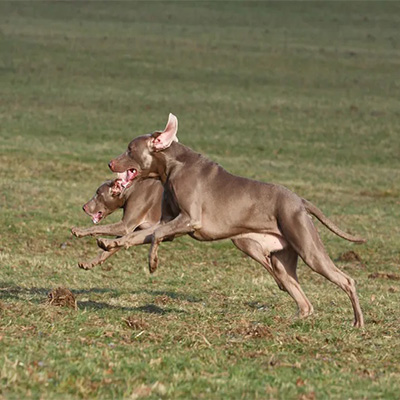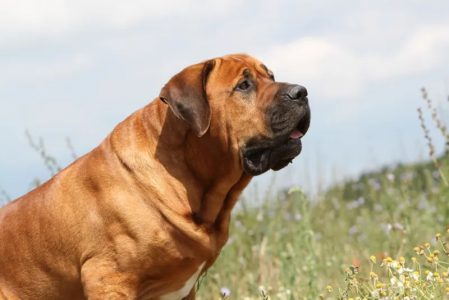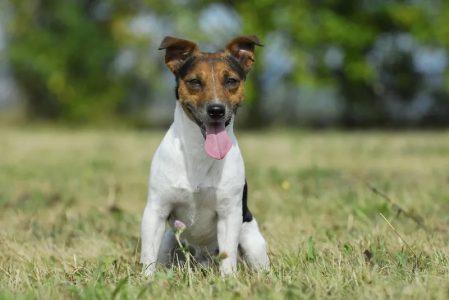Well-socialized Pekingese are very loving with their owner and family, but strangers are treated as intruders. This makes the breed a great watchdog. They are extremely brave, considering their size. They will fight off strangers to death if determined to be a threat.
Afghan Hound
The aristocratic demeanor of this elegant-looking creature goes through to its personality. The Afghan Hound commands attention rather than seeking it out. Beneath the glamorous, long, and shiny coat, you may be surprised to find a stalwart hunter. The Afghan Hound is an ancient breed dating back to the Egyptians and was also found in the Middle Eastern mountains where it was trained to leap after gazelle and smaller prey, like hares.
With a strong instinct and ability to run nimbly through mountain terrain, it requires plenty of outdoor exercises. Adopting an Afghan Hound comes with a commitment to daily exercise and coat care. With this level of attention, this dog is a calm and quiet four-legged friend who loves to jump in bed with you. While the Afghan can be trained to be good with children, it is not a playmate type of dog. This dog will be unhappy without attention and left in the backyard.
Siberian Husky
The Siberian Husky is from Siberia, where it was bred by the Chukchi people to pull sleds. This high-energy dog is not a good couch dog and also not a good backyard dog. They are an intelligent breed easily drawn to mischief and are known to be extremely destructive when bored or left alone. These dogs are avid diggers. Escaping confinement is another strength.
PetVet called the Siberian Husky one of the worst breeds for first-time pet owners, saying, ‘The phrase ‘obedient Siberian Husky’ is something of an oxymoron.” They have a strong predatory drive, so other pets like cats or hamsters may become prey. These pups are prone to howling, reaching loud, siren-like whines. They are great jogging companions, as long as it is cool enough. Their thick coat sheds twice a year. Overall, they are happy, playful, independent-minded dogs.
Rhodesian Ridgeback
The sleek and powerful Rhodesian Ridgeback is distinguished by a streak down its back of reverse-growing hair. It is affectionate, intelligent, and child-friendly. However, this dog is not a good fit for most people. It needs more time and energy than most folks have.
In Rhodesia during the 1870s, this brave dog was known as a good protector against lions. As an intelligent dog, it will become stubborn and strong-willed without proper handling. This breed can become very destructive if it doesn’t get enough exercise and doesn’t recognize any humans as its authority figure. It will likely become combative with other dogs as well. With the proper upbringing, this dog will be a calm, gentle, obedient dog.
Fila Brasileiro
The Fila Brasileiro is another dog on the Dangerous Dogs Act and is banned in the UK, Australia, New Zealand, Norway, and Denmark, to name a few. It is not recommended for first-time dog owners. And, owning one may preclude getting covered by a homeowner’s insurance policy, while legal liability can be costly. They drool and shed profusely and are naturally aggravated by guests or strangers. Bred as hunting dogs, they will protect your family vigorously at any cost.
If you’re still set on this powerful Mastiff, he will need an owner who dominates over it as the alpha. You must be firm, confident, and consistent. A passive owner will find the Fila taking the alpha position. According to Dog Breed Info, “A dog with the massive size and strength of the Fila that believes he is alpha to humans is downright dangerous.”
Border Collie
As the quintessential sheepdog, the Border Collie is revered for its herding instinct and ability. Because it is so well-suited to the energy-intensive task of shepherding, this dog is a ball of energy and excitement. It likes to bark. It’s very territorial, another herding instinct. But it’s also extremely playful and affectionate, loves children, and needs human contact. And, if you need a watchdog, this is the crème de la crème of dogs.
The Border Collie loves its family obsessively and will follow you around the house relentlessly. They develop a very tight bond. Because of its herding instinct, it will try to herd your family, the kids in the yard, and anything and everything it comes across. Chasing after kids on bicycles is included. They develop other obsessive behaviors like chasing bugs, standing guard over the dishwasher until it stops, or watchfully waiting for a child to wake up from a nap. Due to this obsessive nature, a Border Collie has a high tendency toward destruction when bored, ten times higher than the average dog.
Weimaraner
The Weimaraner was bred in Germany during the early 19th century, for courage, intelligence, and excellent scenting abilities to hunt large game. They developed a dog with stamina, speed, and hunting versatility to track down prey of all sizes. This breed hunted deer and bears. The distinctively grey breed’s stunning appearance was immortalized by photographer William Wegman.
This breed is so loyal it will almost smother its human. This means the Weimaraner is very unhappy alone and is vocal about it. It is a high-energy dog that needs plenty of outdoor air. If you have time for a very active dog that wants to be with you all day, you may have found the perfect pet. This breed attaches so much that separation anxiety is a common problem. According to VetStreet, “some Weimaraner’s become so distraught when left to their own devices that they bark, dig, escape, and even injure themselves.” On top of that, they can be difficult to house-train, stubborn, and demanding.
Bull Terrier
Always a popular commercial dog, we recognize the Bull Terrier with its familiar dense head as the Target store mascot Bullseye. Some remember him as Budweiser’s lively Spuds Mac Kenzie. But the adored Bull Terrier is another breed that is not advisable for families who are new to dogs. Breeding of this dog began in the 1900s, but it wasn’t until 1936 that it was accepted as a separate breed.
True, a Bull Terrier is fun-loving, fearless, clownish, active, and obedient, but they are not recommended for all households. Left alone without enough exercise and mental stimulation, these dogs will become destructive and dangerous to small children. They need supervised entertainment, such as running and playing every single day. They are extremely strong dogs with the jaw power of a Pit Bull. They need to be kept away from other pets like rabbits, guinea pigs, and cats.
French Bulldog
If you’re looking for a dog that doesn’t require much exercise, the French Bulldog may be your breed. Frenchies can’t keep up on a jog, can’t swim, can’t tolerate heat, and were bred to be lap dogs. As a brachycephalic, one of the “squished-faced” breeds, the Frenchie can’t regulate body temperature and needs to be indoors in a climate-controlled area. On a positive note, it sheds very little hair.
French Bulldogs are not recommended for first-time dog owners. Because it is brachycephalic, it is prone to disease and other health issues. More importantly, training this dog can be a real challenge. This dog prefers to be the alpha, which makes it aggressive. However, the adorable squished face and perky bat-like ears can be hard to turn away, especially because it’s got an enthusiastic personality and is affectionate with people without being too loud and yappy. But then, he can’t tolerate being alone, so someone must be in the house with it most of the time.
Caucasian Ovcharka
This breed served its duty well, guarding sheep against wolves and herding flocks in the Eastern European Caucasus Mountain region. As a territorial and aggressive dog, it defended diligently against wolves. The Caucasian Ovcharka breed originated in the 1920s. Its name means “sheepdog” in Russian.
The Ovcharka’s thick double coat requires a lot of maintenance and a cool climate. He’s a low-energy breed but also high-strung and strong-willed. If not socialized fully, these dogs can become aggressive. VetStreet says, “While his protective nature may be attractive to some people, the Ovcharka is not an ideal match for novice dog owners. He’s smart, but also an independent thinker, so he needs someone who can guide him with firm, loving, and patient training.”
Catahoula Leopard Dog
As if this breed name was not long enough, the full name is Louisiana Catahoula Leopard Dog. It was used as a working dog on farms in northern Louisiana, and it was in charge of herding hogs to slaughter. Native Americans used this dog to hunt wild game, and the Catahoula acquired its name from those tribes. The Catahoula Leopard is the official Louisiana state dog.
This dog is an affectionate and loyal companion. He needs plenty of exercise and a large, fenced yard. They require firm leadership and lots of walks or jogs. These dogs should always be on a leash. Owners who do not take the alpha role seriously are not recommended for this dog. When dogs live with humans, we become their pack. You must be the pack leader. Otherwise, the dog is making the decisions, and you will not appreciate its leadership skills.
Perro de Presa Canario
This breed originated in the Canary Islands as a livestock dog. Its duty was herding cattle and hogs, and running off, and even killing, predatory dogs in protection of the herd. It’s a powerful animal. VetStreet highly recommends this dog only for owners who are familiar with training dogs. As a story in warning, VetStreet said that in 2006, two Presas killed a woman in San Francisco because the owner was unable to control his dogs.
Early training and socialization classes are mandatory. Training must continue, and the dog must “work” for everything they get, like treats and toys, by performing a command. Professional training is strongly advised. Also, unless the Presa is prevented, they will chase and kill neighborhood cats and small dogs. Instinctively, it has a very strong territorial and prey drive.
Skye Terrier
This dog is a barker. Skye Terriers are also avid diggers. It’s tough, tenacious, and needs a lot of attention. The Skye is also a relentless cat chaser. These dogs are difficult to train, stubborn, and do not get along with other dogs. It has long flowing hair that needs to be groomed or becomes matted in tangles. On the upside, the Skye Terrier can be extremely loyal. One Skye slept on the grave of its dead owner for the rest of its life, fourteen years in all.
The Skye Terrier is a moderately intelligent breed from the Isle of Skye in Scotland. Bred as a working terrier, it was used to hunt foxes, badgers, and otters. The breed enjoyed a highly respected station during the aristocratic Victorian period as fashionable pets of noble ladies after Queen Victoria acquired one. One Skye, named Rona II, even posed in a portrait with the Queen. Since then, the breed has become one of the least known terriers.
Dachshund
Dachshund is German for ‘badger dog’. The short-legged, long-bodied dog was bred to hunt badgers. Chasing them down burrows, the Dachshund was somehow able to outmatch its foe’s tenacity. Dachshunds are fierce and brave. A 2008 study in an academic animal science journal found the Dachshund to be the most aggressive of all dog breeds. Good thing it only stands a few inches off the ground! It comes in three varieties.
The Dachshund is also an inveterate digger thanks to its badger-chasing breeding. The little dog known as the wiener dog, adored by all children for its funny physique, is not a good pet for kids, especially small children. As one of the more aggressive breeds, this little guy can be hostile to strangers and children.
Australian Shepherd
Contrary to its name, the Australian Shepherd originated in North America and was bred as a herding dog in the Western states around the time of the Gold Rush. This is a very active dog that needs a couple of hours of exercise each day. It has very high stamina levels allowing it to work as a herder all day long.
It’s also bold, confident, alert, smart, and responsive, as a herding breed. If these traits are not released with daily exercise, however, these dogs can make life difficult for its humans. Another trait that is unfavorable to a family setting is its propensity to try to herd children and pets. It will nip and use other herding tactics.
Doberman Pinscher
These highly energetic dogs are big and strong and make outstanding guard dogs. But a Doberman Pinscher is not for anybody. It needs extensive training by a handler who is more dominant than the dog. Without the correct attention, a Doberman will become bored, destructive, and vociferous.
The breed was developed by a German tax collector who needed a powerful and dependable guard for the tax monies collected. It was first recognized at an Erfurt dog show in 1897. Dobermans are tall, shorthaired, and full of strength and stamina. They are loyal, tolerant, and dedicated to family. Though the breed is easy to train, few can deliver the consistent, confident, rule-setting guidance it requires. A Doberman can become willful and stubborn if left to its own terms.
Shar-Pei
A defining characteristic of a Shar-Pei is its wrinkly skin, a trait that is especially pronounced in puppies until they gradually grow into their folded flesh. The folds are cute but prone to infection. The folds need to be wiped out with a damp cloth. Like the Chow Chow, Shar-Peis have a dark tongue and were likely cross-bred at some point, as both breeds go back to ancient China.
The Shar-Pei is territorial and aggressive. Like all breeds, it can be trained for proper socialization, but with the Shar-Pei, you will need a professional trainer who starts with it as a puppy. The dog’s aloof attitude, however, may make it a disappointing pet for children. Shar-Peis are not interested in hugs or cuddles, yet need to live inside. It is an intelligent but stubborn breed. This is not the dog for a novice owner.
Belgian Malinois
The Belgian Malinois is not a good breed for children. This dog was bred as a herder, and as a herder, he tends to bite or nip at kids, as if to keep them in line. The Belgian Malinois became a popular breed in the late 1800s when it worked in Belgium either as a shepherd or a guard dog. To this day, the Belgian Malinois remains one of the nation’s most beloved dogs.
This breed is intelligent and obedient, with strong territorial instincts. The master of a Malinois is firm and even-handed. A harsh owner will find a very uncooperative dog. These dogs need vigorous exercise every day. They are high-energy dogs that can become destructive and unmanageable if not properly socialized and trained.
Dogo Argentino
The Dogo Argentino is another breed banned in the UK under the 1991 Dangerous Dogs Act. It was bred in Argentina to be a big-game hunting dog for large prey like pumas. It was also bred to be a protectorate for humans. But because of his predominant traits—stubborn, intelligent, and domineering—the Dogo was banned in several countries.
This dog is not recommended for first-time dog owners. Besides being intelligent and stubborn, a Dogo is large, powerful, and energetic. Without a leader who is just as strong, plus calm, firm, and consistent, a Dogo will be destructive and in charge. Even a trained Dogo will go after your neighbors’ pets, killing cats and small dogs. A high fence is a necessity with a Dogo. This dog is a natural worker, and without something to do, it will likely chew up your personal belongings.
Cane Corso
This dog is intelligent, territorial, and makes a good watchdog. As a mastiff breed from Italy, the Cane Corso is a massive breed raised for hunting large game. These dogs weigh in at 120 pounds. Overall, they are not a good fit for novice dog owners. Even folks who have done well with cooperative breeds like Retrievers and Spaniels are no match for this strong, smart, active, and willful dog.
The Cane Corso will not take to strangers, even after consistent socialization—it’s a guard dog in nature through and through. If you have a Cane, you should walk or run it at least a mile each day. Add to that another 20 minutes of training exercise, and this highly active dog may relax a bit. It’s not advisable to take this strong and aggressive canine to dog parks. Left home alone, a Cane will be very destructive and aggressive. To its credit, the Cane Corso is devoted to its family and very loyal due to its protective, guard dog nature.
Boerboel
The Boerboel, or “farmers dog,” came from South Africa in the 1800s as a protection dog. By 1938, they were used to guard industrial diamond mines. They are very powerful and large, weighing up to 180 pounds. It is an intelligent and stubborn dog and should not be adopted by an inexperienced dog owner.
Experienced dog handlers can bring about a well-socialized pet with continuous training and socialization from an early age. This will help prevent behavior issues and dominating conduct. These dogs have thick coats and enjoy being outdoors in cool weather. Dog parks, however, are not recommended for a dog who is very protective of its family and may attack without warning. Boerboels should always be leashed.
Rottweiler
The Rottweiler has been a successful police dog, herding dog, military dog, and therapy dog. This breed is highly trainable and very loyal. Rottweilers thrive as work dogs and get bored with nothing to do but chew up your sofa. The Rottweiler’s work ethic stretches back as far as Roman days when they were likely used as drover dogs. They are named after the location tiles for roofs of Roman baths were sourced, called Rottweil. The dogs may have come from that German town.
Rottweilers rank second to Pit Bulls for bite fatalities. Some homeowner insurance policies will not cover your house if you have a Rottweiler, and owners are liable for the damage the dog causes. Rottweilers are powerful, large, and extremely protective. At 135 pounds, most of it is muscle, its instinct is to attack a threat. So, you may want to hope it’s not your friend sensed as a threat stopping by. For this reason, it makes a formidable police dog.
Tosa
As descendants of Bulldogs, Great Danes, and Mastiffs, the Tosa is a very large breed weighing up to 200 pounds. Tosas are not ideal for first-time dog owners. Bred for blood sport, you might not want this creature around your young’uns. In fact, the Tosa is a banned breed across four European nations, including the UK.
To board this type of dog, you’ll need a yard with a fence that is at least 6-feet high. Electronic fences are nothing to a Tosa, the shock will not deter this dog. Standing tall, this breed has the athletic look of a warrior. The Tosa’s history goes back to 14th-century Japanese dog fighting. Named for the Tosa Province on Shikoku Island, the Tosa is vigilant, dignified, calm, and courageous. These dogs make excellent guard dogs and caring companions. For training, this eager-to-please breed looks for an abundant supply of positive reinforcement.
ack Russell Terrier
Jack Russel is one tenacious terrier. It digs, barks, jumps, and hunts with relentless abandon. The Jack Russell Terrier (JRT) was bred as a hunting dog. Your garden or living room is fair play if your JRT is after prey. Spiders, mice, and other bugs will be hunted to extinction, and your home will be scratched and dug up.
JRTs tend to fall into behavior problems, like “Small Dog Syndrome”, quite easily. Problems like snapping, separation anxiety, obsessive barking, and guarding may pop up. They are difficult to socialize with and need consistent and firm training by an expert trainer. These dogs need a lot of exercise and a high fence. Climbing and jumping over fences is one of its strengths.
Bernese Mountain Dog
The Bernese Mountain Dog is a cheerful, intelligent breed that loves children. It’s one of the widely recognized Swiss mountain dogs. Its thick, long, and silky coat keep him warm in frosty weather. This mountain dog was able to withstand an Alpine climate and worked as a herder or a flock guard.
The Bernese Mountain Dog is a very large and strong breed. This is not too much of a problem since he is such a gentle giant. But one thing you may want to consider before introducing one of these lovers into your home is its lifespan. A Bernese Mountain Dog lives just six to eight years on average. These dogs are susceptible to cancer. One source from Dog Breed Info said that several of this breed died of cancer between the ages of three and four. One dog as young as two also died from cancer.
Alamy and Shutterstock Stock Photo.

